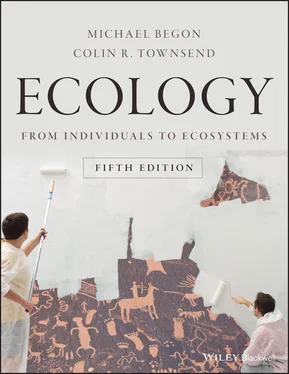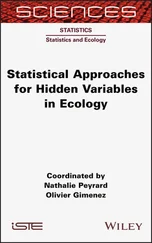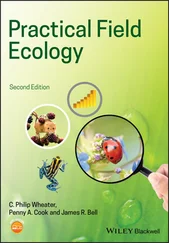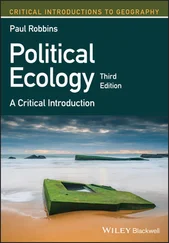Source : After Erickson et al . (2009).
It appears that mortality rates were high amongst the dinosaurs until around the age of three, after which there was another period of around five years during which mortality rates were low even though the animals continued to grow rapidly, which they did until the age of around nine or 10 years ( Figure 4.13b). Mortality rates then seem to have increased again, just as the animals were attaining their maximum size, and broadly coinciding with the appearance in the fossils of characteristics associated with sexual maturity (e.g. enlarged, flaring ‘jugal’ horns). As we shall see in the next chapter, many organisms suffer a cost of reproduction in terms of reductions in growth and/or survival.
Notwithstanding this successful use of a static life table, the interpretation of static life tables generally, and the age structures from which they stem, is fraught with difficulty: usually, age structures offer no easy short cuts to understanding the dynamics of populations.
4.6.4 The importance of modularity
Finally here, we turn to the difficulties of constructing any sort of life table for organisms that are not only iteroparous with overlapping generations but are also modular. We can use a study of the sedge, Carex bigelowii , growing in a lichen heath in Norway, to illustrate this ( Figure 4.14). C. bigelowii has an extensive underground rhizome system that produces tillers (aerial shoots) at intervals along its length as it grows. It grows by producing a lateral meristem in the axil of a leaf belonging to a ‘parent’ tiller. This lateral is completely dependent on the parent tiller at first, but is potentially capable of developing into a vegetative parent tiller itself, and also of flowering, which it does when it has produced a total of 16 or more leaves. Flowering, however, is always followed by tiller death. In other words, the tillers are semelparous although the genets are iteroparous.

Figure 4.14 Reconstructed static life table for the modules (tillers) of a Carex bigelowii population.The densities per m 2of tillers are shown in rectangular boxes, and those of seeds in diamond‐shaped boxes. Rows represent tiller types, whilst columns depict size classes of tillers. Purple‐walled boxes represent dead tiller (or seed) compartments, and arrows denote pathways between size classes, death or reproduction.
Source : After Callaghan (1976).
Callaghan (1976) took a number of well‐separated young tillers and excavated their rhizome systems through progressively older generations of parent tillers. This was made possible by the persistence of dead tillers. He excavated 23 such systems containing a total of 360 tillers, and was able to construct a type of static life table (and fecundity schedule) based on the growth stages ( Figure 4.14). There were, for example, 1.04 dead vegetative tillers (per m 2) with 31–35 leaves. Thus, since there were also 0.26 tillers in the next (36–40 leaves) stage, it can be assumed that a total of 1.30 (i.e. 1.04 + 0.26) living vegetative tillers entered the 31–35 leaf stage. As there were 1.30 vegetative tillers and 1.56 flowering tillers in the 31–35 leaf stage, 2.86 tillers must have survived from the 26–30 stage, and so on. In this way, a life table – applicable not to individual genets but to tillers (i.e. modules) – was constructed.
There appeared to be no new establishment from seed in this particular population (no new genets); tiller numbers were being maintained by modular growth alone. However, a ‘modular growth schedule’ ( laterals ), analogous to a fecundity schedule, has been constructed.
Note finally that stages rather than age classes have been used here – something that is almost always necessary when dealing with modular iteroparous organisms, because variability stemming from modular growth accumulates year upon year, making age a particularly poor measure of an individual’s chances of death, reproduction or further modular growth.
4.7 Reproductive rates, generation lengths and rates of increase
4.7.1 Relationships between the variables
In the previous section we saw that the life tables and fecundity schedules drawn up for species with overlapping generations are at least superficially similar to those constructed for species with discrete generations. With discrete generations, we were able to compute the basic reproductive rate ( R 0) as a summary term describing the overall outcome of the patterns of survivorship and fecundity. Can a comparable summary term be computed when generations overlap?
Note immediately that previously, for species with discrete generations, R 0described two separate population parameters. It was the number of offspring produced on average by an individual over the course of its life; but it was also the multiplication factor that converted an original population size into a new population size, one generation hence. With overlapping generations, when a cohort life table is available, the basic reproductive rate can be calculated using the same formula:
(4.4) 
and it still refers to the average number of offspring produced by an individual. But further manipulations of the data are necessary before we can talk about the rate at which a population increases or decreases in size, or, for that matter, about the length of a generation. The difficulties are much greater still when only a static life table (i.e. an age structure) is available (see later).
the fundamental net reproductive rate, R
We begin by deriving a general relationship that links population size, the rate of population increase, and time – but which is not limited to measuring time in terms of generations. Imagine a population that starts with 10 individuals, and which, after successive intervals of time, rises to 20, 40, 80, 160 individuals and so on. We refer to the initial population size as N 0(meaning the population size when no time has elapsed). The population size after one time interval is N 1, after two time intervals it is N 2, and in general after t time intervals it is N t. In the present case, N 0= 10, N 1= 20, and we can say that:
(4.5) 
where R , which is 2 in the present case, is known as the fundamental net reproductive rate or the fundamental net per capita rate of increase . Clearly, populations will increase when R > 1, and decrease when R < 1. (Unfortunately, the ecological literature is somewhat divided between those who use ‘ R ’ and those who use the symbol λ for the same parameter. Here we stick with R , but we sometimes use λ in later chapters to conform to standard usage within the topic concerned.)
R combines the birth of new individuals with the survival of existing individuals. Thus, when R = 2, each individual could give rise to two offspring but die itself, or give rise to only one offspring and remain alive: in either case, R (birth plus survival) would be 2. Note too that in the present case R remains the same over the successive intervals of time, i.e. N 2= 40 = N 1 R , N 3= 80 = N 2 R , and so on. Thus:
Читать дальше















